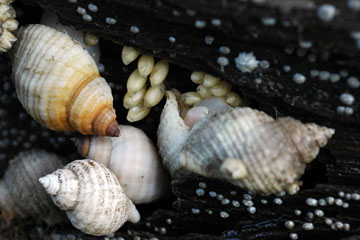 |
 |
|||||||||||||||
|
The dogwhelk reproduces by laying eggs. The males and females gather in the late winter to early spring to mate. The female stores the sperm until she is ready to lay the eggs. She will lay up to 30 egg capsules, that resemble rice grains, in dark, damp crevices or on the undersides of rocks. Each capsule will contain a few hundred eggs, however many of these eggs are not fertilized and serve as food for the developing snails, which resemble miniature adults when they emerge from the egg capsule. The average life span of the dogwhelk is 4-6 years. Its major
predators are crabs and shorebirds. The dogwhelk doesn't venture
higher than the mid-intertidal because it will not survive such a dry
environment. Unlike periwinkles, dogwhelks are unable to tightly seal
their operculum against evaporation, so it must remain in a humid environment.
The dogwhelk breathes or exchanges oxygen through gills located in
the mantle cavity above the head. |
||||||||||||||||
|
||||||||||||||||
|
||||||||||||||||



